KSEEB Class 10 SSLC Biology Chapter 5 Our Environment
The physical and biological world where we live is called our environment. The environment includes our physical surroundings like air (or atmosphere), water bodies, soil (land) and all the organisms such as plants, animals, human beings and micro-organisms like bacteria and fungi (called decomposers).
All these constituents of the environment are dependent on one another. So, all the constituents of environment interact with one another and maintain a balance in the environment in a natural way.
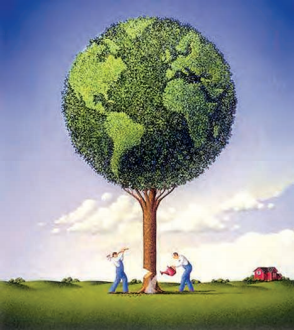
Human beings are the only organisms who change the natural environment to fulfil their needs of food, clothing, housing, transport and industry, etc. In fact, the uncontrolled activities of human beings are damaging the balanced and healthy environment more and more.
KSEEB Class 10 SSLC Biology Chapter 5 Our Environment Biodegradable And Non-Biodegradable Wastes
All the waste materials produced by the various activities of man and animals are poisonous to some extent and can be divided into two main groups :
- Biodegradable wastes, and
- Non-biodegradable wastes.
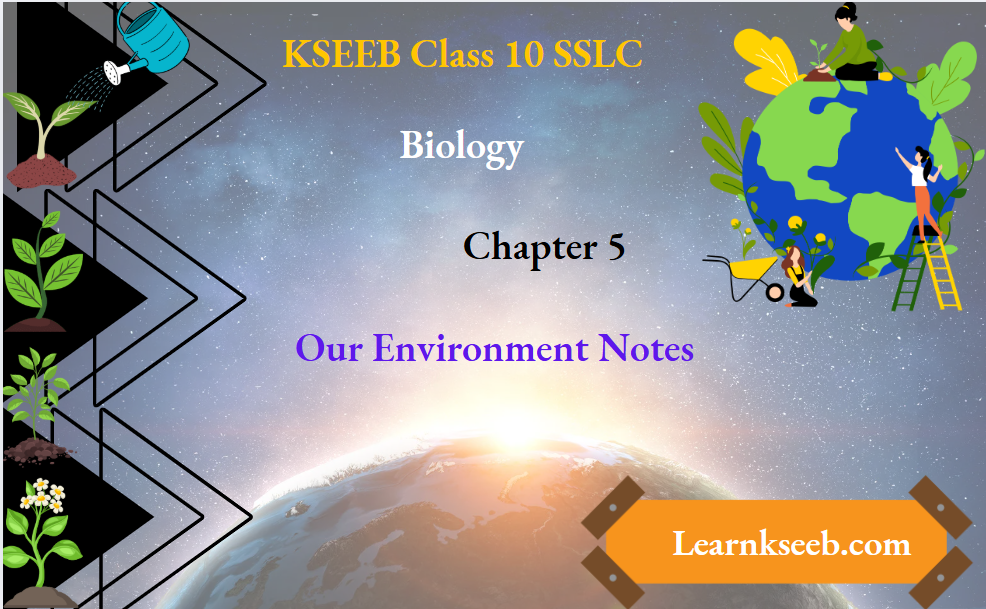
Those waste materials which can be broken down to non-poisonous substances in nature in due course of time by the action of micro-organisms like certain bacteria, are called biodegradable wastes.

- A biodegradable waste decays (decomposes) naturally and becomes harmless after some time. Cattle dung and compost are common examples of biodegradable wastes. [Compost is the manure made from decayed vegetable-stuff (plants)].
- Other examples of biodegradable materials are: Animal bones ; Leather ; Tea- leaves ; Wool ; Paper ; Wheat ; Wood ; Hay ; Cotton ; Jute ; Grass ; Fruit and Vegetable peels ; Leaves, Flowers, and Cake, etc. Biodegradable wastes usually do not pollute the environment.
- Biodegradable wastes pollute the environment only when their amount is large which cannot be degraded (or decomposed) into harmless substances in nature at the right time.
- The waste materials which cannot be broken down into non-poisonous or harmless substances in nature are called non-biodegradable wastes.
- The examples of non-biodegradable wastes are: D.D.T. (Dichloro Diphenyl Trichloroethane); Plastics; Polythene bags; Ball-point pen refill; Synthetic fibres; Glass objects; Metal articles like Aluminium cans; Iron nails; Silver foil and Radioactive wastes.
- All these non-biodegradable wastes cannot be made less toxic (less poisonous) easily and hence they are major pollutants of the environment.
- The non-biodegradable wastes cannot be decomposed by micro-organisms like bacteria. D.D.T. is a non-biodegradable waste so it can be passed along the food chain from crops to man or other animals and birds and harm them.
- For this reason, D.D.T. has been banned from use in most countries. Non-biodegradable wastes are the major pollutants of the environment. For example, the discarded plastic articles, glass articles and metal objects are the non-biodegradable waste materials which cause a lot of pollution in our surroundings.
- We will now describe a simple experiment to find out whether a given material is biodegradable or non-biodegradable. We take a piece of paper, a piece of an old cotton cloth and a plastic bag (polythene bag).

- Dig the ground to about 15 centimetres depth and place the pieces of paper, cotton cloth and plastic bag in the dug up ground separately. We cover them with soil.
- Leave these buried materials in the ground for about a month. After a month, we dig up the buried materials and observe them. We will find that the piece of paper and the piece of cotton cloth have been partially eaten up (or decomposed) but the plastic bag has remained unaffected, it has not been eaten up (or decomposed).
“KSEEB Class 10 Biology Our Environment notes”
- This means that paper and cotton cloth have been decomposed by the micro-organisms present in the soil. So, paper and cotton cloth are biodegradable.
- On the other hand, the plastic bag has not been decomposed by the micro-organisms present in the soil, therefore, plastic is non-biodegradable. So, the decomposer organisms are not able to decompose plastic into simpler harmless substances.
- We will now explain why some materials are biodegradable whereas others are non-biodegradable. The micro-organisms like bacteria and other decomposer organisms (called saprophytes) present in our environment are ‘specific’ in their action.
- They break down the natural materials or products made from natural materials (say, paper) but do not break down man-made materials such as plastics. So, it is due to the property of decomposer organisms of being specific in their action that some waste materials are biodegradable whereas others are non-biodegradable.
- We should use the shopping bags (or carry bags) made of paper, cotton cloth or jute because these are biodegradable materials.
- On the other hand, plastic bags (or polythene bags) should be avoided because plastic is a non-biodegradable material.
KSEEB Class 10 SSLC Biology Chapter 5 Our Environment Ecosystem
- The various communities of living organisms (plants and animals) interact among themselves as well as with their physical environment like soil, air and water. The living organisms interact with one another through their food chains in which one organism consumes another organism.
- The living organisms like plants interact with soil to get essential nutrients like nitrogen, phosphorus, etc.; with air to get carbon dioxide and also with water bodies, for carrying out the process of photosynthesis.
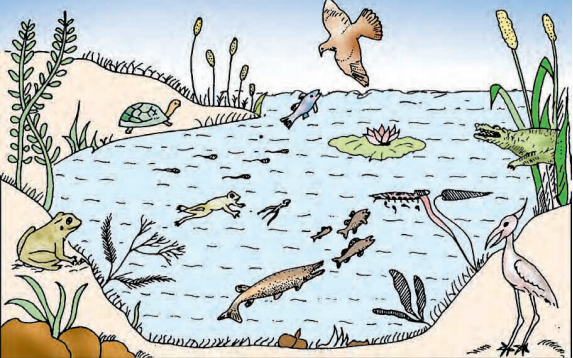
- Thus, the various communities of living organisms (called biotic communities) like plants and animals alongwith soil, air and water of that region form a self-sustaining or functional unit of the living world. This ‘functional unit’ or ‘system’ made up of living and non-living components which is capable of independent existence is called an ecosystem.
- The ecosystem includes all the communities of an area (all the plants and animals of an area) functioning with their non-living environment like soil, air and water. We can now define an ecosystem as follows.
- An ecosystem is a self-contained unit of living things (plants, animals and decomposers), and their non-living environment (soil, air and water). An ecosystem needs only the input of sunlight energy for its functioning. The examples of ecosystems are : a grassland (meadow); a forest; a desert; a mountain; a pond; a lake; a river; and sea.
- When we say that a pond or lake is an ecosystem, then the word pond also includes all the aquatic life (plants and animals) which occurs in this pond water. This is because the living organisms are found everywhere. Similarly, when we say that a forest is an ecosystem then it means the physical environment of the forest like soil, air and water alongwith all the plants and animals which occur in the forest.
- The desert, grassland, forest, cropfield and mountains represent terrestrial ecosystems (land- based ecosystems) whereas ponds, lakes, river, sea and aquarium represent aquatic ecosystems (water- based ecosystems).
- Most of the ecosystems in the world are natural ecosystems but some of them are also man-made ecosystems or artificial ecosystems. The examples of artificial ecosystems are crop-fields (agricultural lands); gardens; parks and aquarium
Components of an Ecosystem
All the ecosystems are made up of two main components: Abiotic components, and Biotic components. Abiotic components mean non-living components and biotic components mean living components. Thus, we can now say that an ecosystem consists of non-living environment and the living biological community.
Abiotic Components of an Ecosystem.
- The abiotic components of an ecosystem (or the non-living components of an ecosystem) include the physical environment like soil, water and air alongwith the inorganic substances like carbon dioxide, nitrogen, oxygen, water, phosphorus, sulphur, sodium, potassium, calcium and other elements present in them. The physical factors or climatic factors like light, temperature, pressure and humidity are also considered abiotic components of the ecosystem.
Biotic Components of an Ecosystem.
- The biotic component of an ecosystem (or the living component of an ecosystem) is a community of organisms (like plants and animals), which is made up of many different inter-dependent populations. The biotic community (or living community) of an ecosystem includes three types of organisms :
- Producer organisms (or Autotrophs) which synthesize their own food. All the green plants are producers.
- Consumer organisms (or Heterotrophs) which are dependent on others for food. All the animals are consumers.
- Decomposer organisms (or Saprotrophs) which consume the dead remains of other organisms. Certain bacteria and fungi are decomposers.
The Functioning of an Ecosystem
- We will now describe how an ecosystem functions as a self-sufficient or independent unit in nature.
- We have just discussed that an ecosystem has non-living components like soil, water and air which contain inorganic nutrient elements, and the living components called producers, consumers and decomposer organisms. All these components make the ecosystem function as follows: From the nutrient pool of the earth (soil, water and air), carbon dioxide and water are absorbed by the producer organisms (green plants).
- With the help of sunlight energy, the producer organisms convert these inorganic substances into organic compounds like carbohydrates which act as a food. Thus, producers trap the solar energy and then provide the basic food or energy for all other life forms in the ecosystem. The consumers (animals) derive their energy needs, directly or indirectly, from producers (plants).
- When the producers (plants) and consumers (animals) die, then the decomposer organisms act on their dead bodies to return the various elements back to the nutrient pool (soil, water and air). Thus, an ecosystem involves input of energy and matter which are exchanged between living and non-living components in a cyclic process.
KSEEB Class 10 SSLC Biology Chapter 5 Our Environment Producers, Consumers and Decomposers
According to the manner in which they obtain their food from the environment, all the organisms can be divided into three groups : producers, consumers and decomposers.
Producers
- Those organisms which produce food are called producers. Producers are the organisms which can prepare their own food from simple inorganic substances like carbon dioxide and water by using sunlight energy in the presence of chlorophyll.
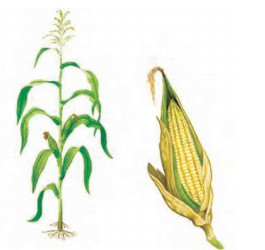
- The examples of producers are green plants and certain blue-green algae. The green plants synthesize their food during photosynthesis by taking raw materials from the earth and energy from the sun The green plants produce carbohydrates by photosynthesis and also synthesize proteins and fats.
- Thus, the green plants are called producers in the living world. Producers are the autotrophic organisms (self- feeder organisms) in the ecosystem upon which other organisms depend for food. Thus, producers (like green plants) are autotrophs.
Consumers
- Those organisms which consume food (eat food) prepared by producers are called consumers. The consumers depend on producers for food, directly or indirectly. The consumers get their food by eating other organisms or their products. In most simple words, consumers are the organisms that eat other organisms.
- All the animals are consumers. Even the microscopic animal life of the water called protozoa are consumer organisms. The examples of common consumer organisms are man, goat, deer, fish, lion, cow and buffalo, etc. The cow and buffalo eat green grass and other green fodder because green grass and other green plants are producers of food.
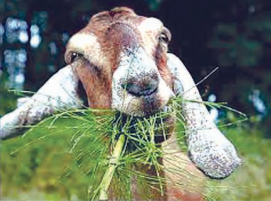
- The bio-mass of grass and plants supplies food and energy to these animals like cow and buffalo. It should be noted that the consumer organisms like animals cannot prepare food from simple inorganic substances through photosynthesis. The consumers need ready-made food for their survival which they get from producers (green plants), either directly or indirectly.
- If an animal eats grass or other green plants or their products itself we say that it gets the food from producers directly. For example, a goat gets the food from producers directly when it eats grass. On the other hand, if an animal eats the meat of another animal (which eats grass), then we say that it gets the food from producer indirectly.
- For example, a lion gets food by eating goat which in turn eats grass. So, in this case the lion gets its food indirectly from producer grass (through the goat). Consumer organisms are also called heterotrophs.Consumers can be further divided into three groups : herbivores, carnivores and omnivores.
Herbivores
Some animals eat only plants (or their products). Those animals which eat only plants are called herbivores. The herbivores may eat grasses, leaves, grains, fruits or the bark of trees. Some of the examples of herbivores are : Cow, Buffalo, Goat, Sheep, Horse, Deer, Camel, Ass, Ox, Elephant, Monkey, Squirrel, Rabbit and Hippopotamus. Cow is called a herbivore because it eats only plants (or plant products) as food. Herbivores are also known as herbivorous animals. The animals which get their food by eating the producers (plants) directly are called primary consumers. Since herbivores obtain their food directly from plants (or producers), therefore, herbivores (like cattle, deer, goat, etc.) are primary consumers.
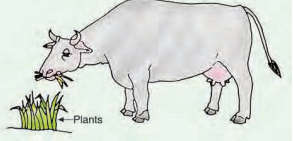
Carnivores
- Some animals eat only other animals. They do not eat plant food at all. Those animals which eat only other animals as food are called carnivores. The carnivores eat the meat (or flesh) of other animals. So, we can also say that those animals which eat only the meat (or flesh) of other animals are called carnivores.
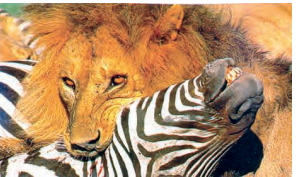
- Some of the examples of the carnivores are : Lion, Tiger, Frog, Vulture, Kingfisher, Lizard, Wolf, Snake and Hawk. Lion is called a carnivore because it eats only the meat (or flesh) of other animals like deer, rabbit and goat, etc. Carnivores are also known as carnivorous animals. The carnivores are usually of two types : small carnivores and large carnivores.
- The small carnivores which feed on herbivores (primary consumers) are called secondary consumers. For example, a frog, lizard, bird and fox, etc., are secondary consumers. The large carnivores (or top carnivores) which feed upon the small carnivores (secondary consumers) are called tertiary consumers.
- For example, lion, tiger and birds of prey (such as hawk) are some of the tertiary consumers. Please note that humans (man) can be primary, secondary or tertiary consumers depending on the food which they eat.
Omnivores
- Some animals eat both, plants as well as other animals. Those animals which eat both, plants and animals, are called omnivores. In other words, the omnivores eat plant food as well as the meat (or flesh) of other animals.
- Some of the examples of omnivores are : Man (human beings), Dog, Crow, Sparrow, Bear, Mynah and Ant. Man is called an omnivore because he eats both, plant food (such as grains, pulses, fruits and vegetables) as well as meat of animals (such as goat, chicken and fish).
- Omnivores are also called omnivorous animals.We will now describe another type of producers and consumers which are extremely small. These are called planktons. Planktons are very minute or microscopic organisms freely floating on the surface of water in a pond, lake, river or ocean. Planktons are of two types : Phytoplanktons and Zooplanktons.
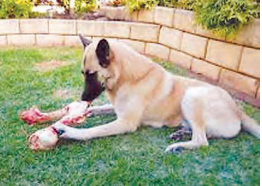
- The microscopic aquatic plants freely floating on the surface of water are called phytoplanktons. The free-floating algae is an example of phytoplankton. Phytoplanktons are capable of producing food by the process of photosynthesis. The microscopic aquatic animals freely floating on water are called zooplanktons.
- The freely-floating protozoa are an example of zooplankton. A very, very small fish is also a zooplankton. Planktons float near the surface of water and provide food for many fish and other aquatic animals.

Decomposers
- The non-green micro-organisms like some bacteria and fungi, which are incapable of producing their food, live on the dead and decaying (rotting) plants and animal bodies and are consumers of a special type called decomposers.
- We can now say that: The micro-organisms which break down the complex organic compounds present in dead organisms like dead plants and animals and their products like faeces, urine, etc., into simpler substances are called decomposers.

- The examples of decomposers are certain bacteria and fungi. The bacteria which act as decomposers are called putrefying bacteria. The bacteria and fungi act as decomposers by the secretions of their body surfaces which decompose the organic matter present in dead plants and animals into simpler substances and liberate ammonia, carbon dioxide, etc.
- They absorb some of these simpler substances for their own maintenance and release the remaining into the soil, water and air to be used by the producers again In this way, decomposers help in the recycling of materials in ecosystem. The decomposers are also known as micro-consumers or saprotrophs.
Importance of Decomposers
- The decomposers help in decomposing the dead bodiesof plants and animals, and hence act as cleansing agents of environment. The decomposers also help in putting back the various elements of which the dead plants and animals are made, back into the soil, air and water for re-use by the producers like crop-plants.
- This maintains the fertility of soil and the soil would continue to support crops again and again. For example, the decomposers like putrefying bacteria and fungi decompose the dead plants and animal bodies into ammonia (and other simpler substances). This ammonia is converted into nitrates by the nitrifying bacteria present in soil.
- These nitrates act as fertilizer in the soil and are again absorbed by the plants for their growth. Thus, it is only due to the presence of decomposers that the various nutrient elements which were initially taken by plants from the soil, air and water are returned to the soil, air and water, after the death of plants and animals.
“SSLC Biology Chapter 5 Our Environment explained”
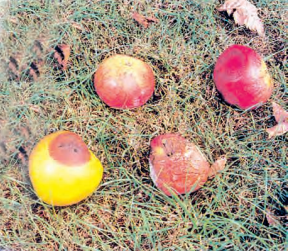
- If, however, there were no decomposers, then the dead bodies of plants and animals would keep lying as such and the elements of which plant and animal bodies are made, would never be returned to their original pools like soil, air and water. In that case, the cyclic process of life and death would be disrupted.
- This is because in the absence of decomposers the soil, air and water would not be replenished by elements from the bodies of dead organisms. All the nutrients present in soil, air and water would soon be exhausted and evolution of life would come to an end.
- Thus, the decomposer organisms help in recycling the materials in the ecosystem so that the process of life may go on and on like an unending chain.
KSEEB Class 10 SSLC Biology Chapter 5 Our Environment Food Chains
- Anything which we eat to live is called food. Food contains energy. The food (or energy) can be transferred from one organism to the other through food chains. The starting point of a food chain is a category of organisms called producers.
- Producers are, in fact, plants. So, we can say that all the food chains begin with a green plant (or grass) which is the original source of all food. Let us take an example to understand the meaning of food chain.

- Suppose there is a field having a lot of green plants (or producers of food). Now, plants can be eaten up by a rat. The rat, in turn, can be eaten up by a cat. And finally, the cat can be eaten up by a dog. So, we find that there is a sequence (or order) in which one organism eats up the other organism (or consumes the other organism) to fill its belly.
- The sequence of living organisms in a community in which one organism consumes another organism to transfer food energy, is called a food chain. In simple words, a list of organisms (living beings) showing “who eats whom” is called a food chain.
- Let us make this point more forest, there is a lot of grass (which are green plants). This grass is eaten up by animals like deer. And this deer is then consumed (eaten up) by a lion. This simple food chain operating in a grassland or forest can be represented as :
- Grass ——————- Deer———————— Lion
- (Producer) ———–(Herbivore) —————–(Carnivore)
- This food chain tells us that grass is the starting point of this food chain. The grass is eaten up by deer and the deer is then eaten up by a lion. In this food chain, grass is the producer organism which uses sunlight energy to prepare food like carbohydrates by the process of photosynthesis.
- This grass is then consumed by a herbivore called deer. And the deer is consumed by a carnivore called lion. The above food chain can be represented more clearly .
- A food chain represents a single directional (or unidirectional) transfer of energy. For example, theabove food chain tells us that the transfer of energy takes place from grass to deer and then to lion. It cannot take place in the reverse direction from lion to deer to grass. The study of food chains in an area or habitat helps us in knowing various interactions among the different organisms and also their interdependence.
More Examples of Food Chains
- In the food chain that we have discussed above, there are three organisms involved in it : grass, deer and lion, so it is said to be a food chain having three steps or three links.
- The same grassland has many other food chains operating in it which can have different number of steps. Let us take the example of a grassland food chain having four steps or four links.
- In a grassland ecosystem, grass is eaten by insects; the insects are eaten by frog; and the frog is then eaten by birds. This is a grassland food chain involving four organisms (or four steps) which can be represented as follows :


- Please note that in this food chain grass is the producer. The insect (herbivore) is the primary consumer, the frog (small carnivore) is the secondary consumer whereas the bird (top carnivore or large carnivore) is the tertiary consumer.
- Another four-step food chain operating in a grassland is :
- Plants —————-Worms—–———– Birds —————Cat (Producer)——– (Herbivore)———– (Carnivore)——–(Top carnivore)
- We will now discuss the food chain operating in an aquatic ecosystem (water ecosystem) like a pond, lake, or sea (ocean). In a pond, lake or sea ecosystem, the algae are eaten up by protozoa; the protozoa are eaten up by small fish; and the small fish is eaten up by big fish. This aquatic food chain can be represented as :
- Algae —————-Protozoa ———-Small Fish ———– Big Fish (Phytoplankton)
- Please note that in a pond, lake or ocean ecosystem, the producer is a minute organism called algae and protozoa is the minute herbivore.
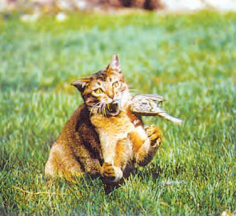
- Each organism (or living being) occupies a specific position in the food chain. For example, grass, deer and lion occupy specific positions in the food chain :
- Grass —————————-Deer ——–————————Lion
- Another point to be noted is that one organism (or same organism) can occur in more than one food chains. For example, in the forest food chains, a deer may be consumed by a lion as well as by a jackal :
- Grass————————– Dee——————————- Jackal
- So, the same organism, deer, occurs in the food chains of lion as well as that of jackal. The organisms representing producers and consumers in a food chain give a definite structure to an ecosystem.
KSEEB Class 10 SSLC Biology Chapter 5 Our Environment Food Web
- A large number of food chains exist in a community of living organisms in an ecosystem such as a grassland, a forest, a pond or a crop-field. Many of these food chains are inter-connected by species (organisms) which occur in more than one food chain.
- The inter-connected food chains operating in an ecosystem which establish a network of relationships between various species, is called a food web. In simple words, the network of a large number of food chains existing in an ecosystem is called a food web.
- The food web has many intercrosses and linkages among the various species (producers and consumers) present in it. This means that the various food chains in an ecosystem do not operate in isolation (or alone). They operate in the form of a net-work of food chains called food web. A food web.
- This is a food web. A food web consists of many inter-connected food chains. In this food web, we can see a network of numerous pathways along which the food (or energy) flows within grassland community.
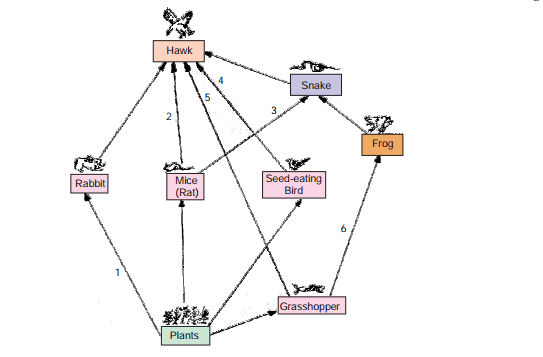 This food web starts from the plants which is a producer and ends in top carnivore hawk (baaz). There are as many as six food chains operating in the food web shown above which have been marked 1, 2, 3, 4, 5 and 6.
This food web starts from the plants which is a producer and ends in top carnivore hawk (baaz). There are as many as six food chains operating in the food web shown above which have been marked 1, 2, 3, 4, 5 and 6.
- In the 1st food chain, plants are eaten by rabbit and then rabbit is eaten by hawk : Plants ——- Rabbit ——– Hawk
- In the 2nd food chain, plants are eaten by mice (or rats) and the mice are eaten by hawks : Plants ——– Mice ——– Hawk
- In the 3rd food chain, plants are eaten by mice; mice are eaten by snakes and then snakes are consumed by hawks : Plants ——– Mice——–Snake ——– Hawk
- In the 4th food chain, plants are eaten by seed-eating birds and the seed-eating birds are consumed by hawks : Plants ——– Seed-eating Bird ———– Hawk
- In the 5th food chain, plants are eaten up by grasshopper and the grasshopper is consumed by hawks: Plants Grasshopper Hawk
- In the 6th food chain, plants are eaten by grasshopper, grasshopper is eaten by frog, frog is eaten by snake and then snake is consumed by hawk : Plants——-Grasshopper ——–Frog——- Snake —–Hawk
KSEEB Class 10 SSLC Biology Chapter 5 Our Environment Trophic Levels
- A food chain represents the flow of food (or energy) in a given set of organisms or living beings. The various steps in a food chain at which the transfer of food (or energy) takes place are called trophic levels. In fact, in a food chain, each step representing an organism forms a trophic level. In most simple terms, ‘trophic level’ means ‘feeding level’ of the organism.
“KSEEB SSLC Our Environment chapter summary”
- The plants are producers (or autotrophs) and constitute the first trophic level. They fix up the sun’s energy and make it available for consumers (or heterotrophs).
- Herbivores (which feed upon plants) constitute the second trophic level.
- Carnivores (that feed upon herbivores) constitute the third trophic level.
- Large carnivores or Top carnivores (which feed upon small carnivores), constitute the fourth trophic level.
The various trophic levels in a food chain can be represented diagrammatically.

- Top carnivores (Fourth trophic level)Carnivores (Third trophic level) Herbivores(Second trophic level) Producers (First trophic level) Tertiary consumers Secondary consumers Primary consumers Producers.
- Herbivores are called primary consumers, small carnivores are called secondary consumers whereas top carnivores or large carnivores are called tertiary consumers. So, we can draw another diagram to represent various trophic levels by using the terms producers, primary consumers, secondary consumers and tertiary consumers.
- Please note that both, secondary consumers and tertiary consumers are carnivores, the only difference being that secondary consumers are small carnivores (though we usually do not write the word small), whereas tertiary consumers are large carnivores which are usually called top carnivores is tapering upwards because as we go up towards higher trophic levels, the number of organisms in them decreases gradually.
- The simplest food chain that we have already studied is :

- Now, this food chain involves three trophic levels. Grass (being producer) represents the 1st trophiclevel. Deer (being herbivore) represents the 2nd trophic level, and lion (being carnivore) represents the third trophic level.
- We have also studied another food chain operating in the grassland, which is :
 In this food chain, grass represents the 1st trophic level; insects represent the 2nd trophic level; frog represents the 3rd trophic level, whereas birds represent 4th trophic level. This is shown more clearly.
In this food chain, grass represents the 1st trophic level; insects represent the 2nd trophic level; frog represents the 3rd trophic level, whereas birds represent 4th trophic level. This is shown more clearly.
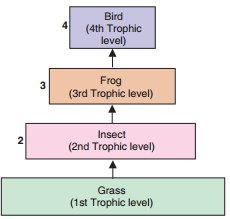
- We will now consider some of the food chains involving man(human beings). Now, when man eats plants (or plant products), then the food chain involves only producer and consumer

- This food chain has only two trophic levels. Plants being the first trophic level and the man representing second trophic level. But in the case of man who also eats meat (of animals like goat), the food chain involves producer and two consumers, the primary consumer and the secondary consumer :

- This food chain involving man has three trophic levels. Plants represent 1st trophic level, goat represents 2nd trophic level whereas man represents the 3rd trophic level.
- The trophic levels in a food chain can also be represented by pyramid of numbers. Thus, if we count the number of species (or organisms) living at each trophic level in a food chain, then we can represent the food chain by a pyramid of numbers. A pyramid of numbers showing the various trophic levels in the grassland food chain :
- Plants –Mice –Snakes–Hawks The base of this pyramid is formed by producers (plants) and the top of this pyramid is formed by the highest order consumers (or top carnivores)
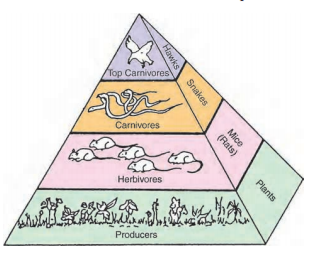
- Please note that the same ecosystem may besupporting many different pyramids of organisms, each starting with plants at the base but ending in a different organism at the top. Another point to be noted is that there is a greater number of organisms at the lower trophic levels of an ecosystem (the greatest number being at the producer level). As we go to higher and higher trophic levels, the number of organisms in each trophic level goes on decreasing.
Effect of Man’s Activities on the Ecosystem
- Man or for that matter, any other living organism must interact properly with the rest of the ecosystem because he is an integral part of that ecosystem. Some of the man’s activities like hunting of various animals disrupt the food chains in which these animals normally take part.
- This disruption of one food chain affects the numerous other food chains operating in the food web. The shortening of food chains due to man’s activities like hunting leads to an imbalance in the functioning of an ecosystem and ultimately in the functioning of the whole biosphere. The effect of man’s activities on the functioning of an ecosystem will become clear from the following examples.
- The formation of Sahara Desert is an example of the ill effect of man’s activities on the delicately balanced ecosystem.
 When the Romans started capturing lions, the population of lions in the forest was reduced to a large extent Lion is a predator which kills the herbivorous animals like deer, sheep, goat, buffalo, etc. Now, since the population of predator lion decreased, there was no one to kill the herbivorous animals. Due to this the population of herbivorous animals increased rapidly.
When the Romans started capturing lions, the population of lions in the forest was reduced to a large extent Lion is a predator which kills the herbivorous animals like deer, sheep, goat, buffalo, etc. Now, since the population of predator lion decreased, there was no one to kill the herbivorous animals. Due to this the population of herbivorous animals increased rapidly.- The large population of these herbivorous animals ate up all the vegetation (plant materials) in that region, turning the lush-green forests into vast desert called Sahara Desert. Our own Rajasthan Desert was formed as a result of overgrazing of vegetation by progressively increasing tribes of herbivorous animals which occurred due to the reduction in the predator population of lions because of excessive hunting and capturing.
- Let us take the example of Grass —Deer —-Lion food chain to study the effect of man’s activities on the ecosystem. A natural ecosystem is a delicately balanced system. If the man does not disturb this ecosystem, then the organisms like grass, deer and lion in a forest keep a natural balance which benefits them all and gives us a healthy environment. We will now discuss the effect of removing all the three organisms from this food chain, one at a time.
If All the Lions are Removed
- If all the lions in a forest are removed by killing or capturing, then there will be no predator control over the population of deer. Due to this the population of deer will increase greatly. Deer eat grass. So, an increase in deer population will lead to excessive grazing of grass. The density of producers like grass will be very much reduced. Overgrazing may even eliminate the grass and other green plants completely and turn the lush-green forest into a desert area having no vegetation at all.
“Class 10 Karnataka Board Biology Chapter 5 notes”
If All the Deer are Removed
- Deer is a food (or prey) for lion. Now, if somehow, all the deer population from a forest is removed, then there will not be sufficient food for the lions. Some of the lions will die because of starvation and hence the population of lions will decrease.
- The decrease in population of lions will disturb other food chains in which lions operate. The hungry lions of the forest can come out of the forest in search of food and may even kill domestic animals or human beings for obtaining food.
- If the lion and deer are operating in other food chains of the food web, the removal of deer population and the subsequent reduction in lion population will disturb the balance of ecosystem.
If All the Producers are Removed
- If all the producers like grass and other plants are removed, then no deer or lion (or any other organism) will be able to exist. This is because the food and energy necessary for sustaining life is derived from the producer organisms like grass, plants and their products.
- From the above examples we conclude that if we kill all the organisms in one trophic level, it will cause too much damage to the environment. So, we cannot remove all the organisms of a trophic level without causing any damage to the ecosystem.
- The impact of removing all the organisms of a trophic level will be different for different trophic levels (as explained in the above given examples). We will now answer some questions based on trophic levels.
Sample Problem 1. Which of the following belong to the same trophic level ?
Grass; Hawk; Rabbit; Frog; Deer
Solution. Here, grass is a producer, hawk is a top carnivore, rabbit is a herbivore, frog is a carnivore and deer is a herbivore. Since rabbit and deer are both herbivores, so they belong to the same trophic level (2nd trophic level).
Sample Problem 2. Which of the following belong to the same trophic level ?
Frog; Grasshopper; Grass; Snake; Algae
Solution. Here, frog is a carnivore, grasshopper is a herbivore, grass is a producer, snake is a top carnivore, and algae is producer. Since grass and algae are both producers, so they belong to the same trophic level (1st trophic level)
KSEEB Class 10 SSLC Biology Chapter 5 Our Environment The Sun Provides Energy For Maintaining All Life On Earth
All the organisms (plants and animals) depend on the sun for their constant need of energy, and upon earth for the materials which enter into their body. We will now describe how energy received from the sun flows in the various trophic levels of an ecosystem in the form of chemical energy of food.
KSEEB Class 10 SSLC Biology Chapter 5 Our Environment Transfer Of Energy In Food Chains
- The food chain in a community actually represents a stepwise transfer of food and the energy contained in food. The food and energy enter the living components of the ecosystem through the process of photosynthesis.
- This is because photosynthesis is a process which combines the substances like carbon dioxide, water and sunlight energy to form food like carbohydrates and converts light energy of the sun into chemical energy of carbohydrates.
- This food and energy is then transferred from the producer organisms to herbivores and from herbivores to carnivores, through the food chain. Let us discuss this flow of energy in detail.
First Step
- The green plants (or producers) have a mechanism for trapping solar energy (sun’s energy) with the help of their green pigment called chlorophyll. The green plants after trapping the solar energy, convert it into chemical energy which is stored as carbohydrates in the plants.
- Thus, the initialpoint where energy from the environment enters into the living components of ecosystem (like plants and animals) is theprocess of preparation of food by green plants through photosynthesis. On an average, about 1% of the sun’s energy falling on the leaves is used by the plants in the process of photosynthesis and stored as chemical energy of food.
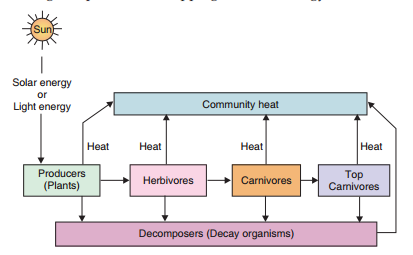
- The plants utilisethe energy stored in them for their metabolicactivities like respiration and growth (tissue building). Some of the energy is, however, not utilized and it is released as unusable heat into the community environment.
Second Step
- The plants (or producers) are eaten up by herbivores. The chemical energy stored in plant food is transferred with food to herbivores. The herbivores utilize this energy for their various metabolic activities like respiration and also for their growth. Some of the energy, however, remains unutilized which is released by the herbivores as heat energy to the environment.
Third Step
- The herbivores are eaten up or consumed by carnivores. The chemical energy stored in the flesh of herbivores is transferred with food (or flesh) to the carnivores. The carnivores utilize this energy for their various metabolic activities like respiration and also for their growth. Some of the energy, however, remains unutilized by the carnivores and it is released as heat energy into the environment.
- This process of the transfer of energy is repeated with large carnivores or top carnivores (who eat small carnivores), and so on. It should be noted that some of the energy from producers and consumers (like plants, herbivores and carnivores) is also utilized for the life processes of micro-organisms called decomposers.
“Detailed notes on Our Environment for Class 10 SSLC”
The decomposers, in turn, release the unutilized energy as heat into the environment.
- It is obvious from the above discussion that the energy which remains unutilized by producers, consumers (herbivores and carnivores) and decomposers is lost into the environment as heat. It is called community heat. We should remember the following points about the transfer of energy in the ecosystem :
- Energy is not created in the ecosystem. Energy is only converted from one form to another. For example, light energy coming from the sun is converted into chemical energy of food like carbohydrates by the process of photosynthesis. Thus, photosynthesis converts light energy into chemical energy.
- There is a continuous transfer of energy from one trophic level of organisms to the next trophic level in a food chain. For example, producers like plants transfer energy to the herbivorous animals like deer, and the herbivorous animals like deer transfer energy to carnivorous animals like lion, so that there is a continuous transfer of energy in the food chain : Plants o Deer o Lion. This transfer of energy takes place in the form of chemical energy of food.
- At each trophic level of organisms, some of the energy is utilized by the organisms for their metabolic
- A part of the energy at each trophic level (like producers, herbivores and carnivores) is utilized for the functioning of decomposers.
- There is a loss of energy at each energy transfer in various trophic levels of organisms which goes into the environment and remains unutilized. In other words, we can say that the amount of energy available at each successive trophic level is less than the energy available at the producer level. Thus, when we move from the first trophic level of producers (plants) to second trophic level of herbivores and thirdtrophic level of carnivores, the amount of energy available gradually decreases. This is because at each trophic level, energy is lost as heat energy which goes into the environment.
Flow of Materials in Ecosystem is Cyclic but Flow of Energy is Unidirectional
- The materials like water, carbon (as carbon dioxide) and nitrogen (as minerals) are taken up by the plants from soil, air and water bodies, etc., and made into food. This food is then passed on to the animals like herbivores and carnivores in a food chain.
- After the death and decay of plants and animals, the materials like water, carbon and nitrogen present in their bodies are returned to soil, air and water, from where they were taken originally. These materials can then be reused for the growth of new plants. In this way, the same materials are used again and again, the materials are not lost from the environment. of materials like water, carbon and nitrogen, etc., in the ecosystem is said to be cyclic. This is not so in the
case of energy.
- The flow of energy in the ecosystem is unidirectional (or one-directional). The energy enters the plants (from the sun) through photosynthesis during the making of food. This energy is then passed on from one organism to another in a food chain. Energy given out by the organisms as heat is lost to the environment, it does not return to be used by the plants again. This makes the flow of energy in ecosystem ‘unidirectional’. ecosystem is said to be unidirectional because the energy lost as heat from the living organisms of a food chain cannot be reused by plants in photosynthesis.
Ten Percent Law
- During the transfer of energy through successive trophic levels in an ecosystem, there is a loss of energy all along the path. No transfer of energy is 100 per cent. The studies of transfer of energy in different food chains in a large number of ecosystems has revealed a uniform pattern of transfer of energy, which is given by 10 per cent law. The 10 per cent law which was given by Lindeman in the year 1942, is one of the most useful generalisations about the magnitude of loss of energy in food chains.
- According to ten per cent law, only 10 per cent of the energy entering a particular trophic level of organisms is available for transfer to the next higher trophic level. All the energy transfers in food chains follow the 10% law which in simple terms means that the energy available at each successive trophic level is 10 per cent of the previous level. Thus, there is a progressive decline (gradual reduction) in the amount of energy available as we go from producer level to the higher trophic levels of organisms.Let us take one example to understand the 10 per cent law more clearly.
- Suppose 1000 joules of light energy emitted by the sun falls on the plants (called producers). We know that the plants convert only one per cent (1%) of the light energy falling on them into chemical energy of food. So, the energy which will be available in plant matter as food will be only 1% of 1000 joules, which comes to 10 joules. The remaining 1000 – 10 = 990 joules of light energy or solar energy which is not utilized by the plants is reflected back into the environment . Please note that the ten per cent law will not apply at this stage. It will apply only in the transfer of energy in the food chain.
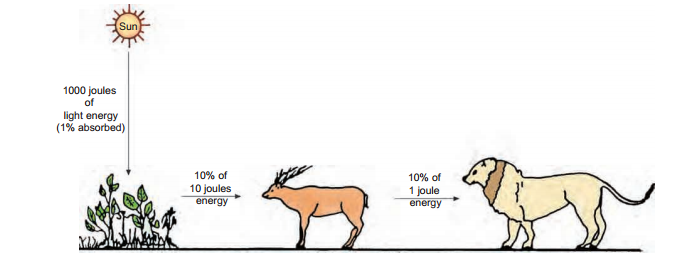 We will now apply the 10 per cent law to the food chain : Plants-Herbivores -Carnivores . The plants or first trophic level has 10 joules of energy in it. Now, according to ten per cent law, only 10% of 10 joules of energy (which is 1 joule) will be available for transfer at the next trophic level, so that the herbivore (deer) will have only 1 joule of energy stored as food at the second trophic level . Applying the ten per cent law again we find that 10% of the remaining 1 joule (which is 0.1 joule) will be transferred to third trophic level of carnivore (lion). So, the energy available in the lion as food will be only 0.1 joule. We will now solve some problems based on ten per cent law.
We will now apply the 10 per cent law to the food chain : Plants-Herbivores -Carnivores . The plants or first trophic level has 10 joules of energy in it. Now, according to ten per cent law, only 10% of 10 joules of energy (which is 1 joule) will be available for transfer at the next trophic level, so that the herbivore (deer) will have only 1 joule of energy stored as food at the second trophic level . Applying the ten per cent law again we find that 10% of the remaining 1 joule (which is 0.1 joule) will be transferred to third trophic level of carnivore (lion). So, the energy available in the lion as food will be only 0.1 joule. We will now solve some problems based on ten per cent law.
Sample Problem 1. Calculate the amount of energy available to lion in the following food chain if plants have 20000 J of energy available from the sun : Plants —–Deer ———Lion
- Solution. Plants can trap only 1% of the sun’s energy falling on them. Now, 1% of 20000 J is 200 J, so the plants have actually 200 J of energy available in them as food (The 10 per cent law does not apply at this stage).
- The plants are eaten up by deer. Now, according to 10 per cent law, 10% of 200 J, that is, 20 J ofenergy will be available in deer as flesh food.
- The deer will transfer 10% of its 20 J energy to the lion. Thus, the food energy available to the lionwill be 10% of 20 J which comes to 2 J.The above results can be shown more clearly as follows :

Sample Problem 2. Consider the following food chain :
Grass ————- Mice ————-Snakes ————Peacocks
If in this chain, 100 J of energy is available at the producer level, then calculate the energy transferred to the peacocks as food. State the law used in the calculations.
Solution. The producer level in this food chain is grass, so 100 J of energy is available in grass as food.
We have now to apply 10 per cent law to the above food chain :
- According to ten per cent law, 10% of the energy of grass will be available as food in mice. Thus, the energy available to mice will be 10% of 100 J, which is 10 J.
- The energy available to snakes will be 10% of 10 J which is 1 J.
- And finally, the energy available to peacocks will be 10% of 1 J, which is 0.1 J.
The above conclusions can now be depicted as follows :
![]()
Why the Number of Trophic Levels in a Food Chain is Limited
- At each trophic level in a food chain, a large portion of the energy is utilized for the maintenance of organisms which occur at that trophic level and lost as heat. As a result of this, organisms in each trophic level pass on less and less energy to the next trophic levels, than they receive.
- The longer the food chain, the less is the energy available to the final member of food chain. Food chains generally consist of three or four steps (three or four organisms) because after that the energy available for the next organism will be so small that it will be insufficient to sustain the life of that organism.
- There are, however, some food chains containing five steps (or five organisms) but there are rarely more than five steps (or five organisms) in a food chain. We will now discuss the accumulation of harmful chemicals in food chains.
Accumulation of Harmful Chemicals in Food Chains
- The accumulation of harmful chemicals such as pesticides in the living organisms like plants, animals and humans (men) unknowingly, through the food chain, is called bioconcentration of pesticides. This happens as follows.
- Pesticides are poisonous chemical substances which are sprayed over crop plants to protect them from pests (harmful small animals) and diseases. These chemical pesticides mix up with soil and water.
 From soil and water, these pesticides are absorbed by the growing plants alongwith water and other minerals When herbivorous animals eat plant food, then these poisonous chemical pesticides go into their bodies hrough the food chain. And when the carnivorous animals eat herbivores, then the pesticides get transferred to their bodies. Man being an omnivore, eats plant food as well as herbivores.
From soil and water, these pesticides are absorbed by the growing plants alongwith water and other minerals When herbivorous animals eat plant food, then these poisonous chemical pesticides go into their bodies hrough the food chain. And when the carnivorous animals eat herbivores, then the pesticides get transferred to their bodies. Man being an omnivore, eats plant food as well as herbivores.- So, the pesticides present in plant food and herbivores also get transferred to the man’s body through food. Thus, pesticides enter the food chain at the producer level (plant level) and in the process of transfer of food through food chains these harmful chemicals get concentrated at each trophic level. The increase in concentration of harmful chemical substances like pesticides in the body of living organisms at each trophic level of a food chain is called biological magnification.
- Pesticides are non-biodegradable chemicals, so they get accumulated at each trophic level. Since humans occupy the top level in any food chain, so the maximum amount of harmful chemical pesticides gets accumulated in our bodies.
- This damages our health gradually. Tests have shown that the most commonly used pesticide DDT is accumulating in our bodies through the food chains. Please note that the pesticides present in our food grains (like wheat, rice), fruits, vegetables, and meat cannot always be removed by washing, etc. Let us solve one problem now.
Sample Problem. Which of the following will have the maximum concentration of harmful chemicals in its body ?
Peacock, Frog, Grass, Snake, Grasshopper
Solution. In order to answer such questions, we should first write the food chain involving the given organisms. The organism which occurs at the highest trophic level (on the extreme right side) in the food chain will have the maximum concentration of harmful chemicals in its body. In this case, grass is eaten by grasshopper; grasshopper is eaten by frog; frog is eaten by snake and finally snake is eaten by peacock. So,the food chain will be :
Grass ——– Grasshopper ——– Frog ——-Snake —- Peacock
In this food chain, since peacock occurs at the highest trophic level (on the extreme right side), therefore, peacock will have the maximum concentration of harmful chemicals in its body.
How do Our Activities Affect the Environment
We (human beings) are an important part of the environment. Our activities change the environment around us. And the changes in environment then affect us. We will now discuss two environmental problems caused by our activities : depletion of ozone layer, and disposal of domestic wastes (or household garbage).
KSEEB Class 10 SSLC Biology Chapter 5 Our Environment Depletion Of Ozone Layer
- We know that oxygen is O2. Oxygen molecule is made up of 2 atoms of oxygen combined together. Oxygen gas is essential for life because it is needed in respiration. Ozone is O3. Ozone molecule is made up of 3 atoms of oxygen combined together.
- Ozone is also a gas but it is poisonous in nature (if inhaled). Let us see how ozone is formed. Ozone is formed high up in the atmosphere by the action of ultraviolet radiation on oxygen gas. This happens as follows : The high energy ultraviolet radiation (UV radiation) coming from the sun splits oxygen gas into free oxygen atoms.
![]()
- The free oxygen atoms thus produced are very reactive. One oxygen atom reacts with an oxygen molecule to form an ozone molecule :
![]()
- At a height between 15 kilometres and 60 kilometres, there is a layer of ozone gas (O3) in the upper atmosphere. This ozone layer is very important for the existence of life on earth because it absorbs most of the harmful ultraviolet radiations coming from the sun and prevents them from reaching the earth. The ultraviolet radiations have extremely harmful effects on human beings, other animals as well as plants.
- For example, ultraviolet rays can cause skin cancer. They also damage the eyes by causing an eye disease called cataract. Ultraviolet rays damage immune system by lowering the body’s resistance to diseases.
 Thus, it is the ozone layer in the upper atmosphere which protects us from these diseases by absorbing ultraviolet rays coming from the sun.
Thus, it is the ozone layer in the upper atmosphere which protects us from these diseases by absorbing ultraviolet rays coming from the sun.- It has now been found that the amount of ozone is getting depleted (or reduced) due towhich the ozone layer in the upper atmosphere is becoming thinner and thinner day by day. The depletion of ozone layer is due to the use of chemicals called chlorofluorocarbons.
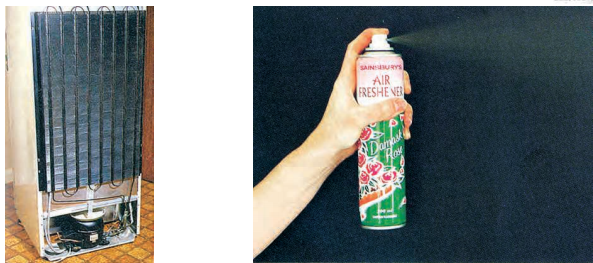 This happens as follows : Chlorofluorocarbons (CFC) are the chemicals which are widely used in refrigeration (refrigerators and air conditioners) as a coolant; in fire extinguishers and in aerosol sprayers.
This happens as follows : Chlorofluorocarbons (CFC) are the chemicals which are widely used in refrigeration (refrigerators and air conditioners) as a coolant; in fire extinguishers and in aerosol sprayers.- Chlorofluorocarbons released into the air react with ozone gas present in the ozone layer and destroy it gradually. Due to this, the ozone layer in the upper atmosphere has become thinner, allowing more ultraviolet rays to pass through it to the earth.
- Thus, due to the depletion of ozone layer caused by chlorofluorocarbons, more ultraviolet radiations reach the earth.
- if the ozone layer in the atmosphere disappears completely, then all the extemely harmful ultraviolet radiations coming from the sun would reach the earth. These ultraviolet radiations would cause skin cancer
and other ailments in men and animals, and also damage the plants. All the life on the earth would be destroyed gradually. In 1987, in an attempt to protect ozone layer, the United Nations Environment Programme (UNEP) forged an agreement among its member countries to freeze CFC production at 1986 levels.
KSEEB Class 10 SSLC Biology Chapter 5 Our Environment Managing The Garbage We Produce
The household wastes (or rubbish) is called garbage. Every household produces a lot of garbage (or wastes) daily. This garbage includes left-over food, fruit and vegetable peels, fallen leaves of potted plants, waste paper, unwanted plastic objects (such as plastic bottles, polythene bags, toys, etc.), glass articles (like glass bottles, broken window panes, etc.), metal objects (like aluminium foils, rusted iron grills, etc.), old wooden objects, rags (old, torn clothes), discarded shoes, and sewage. Some of the garbage (or waste) is biodegradable whereas a major part of it is non- biodegradable. If the household garbage or waste is not disposed of properly, it can pollute the environment like soil, water and air.
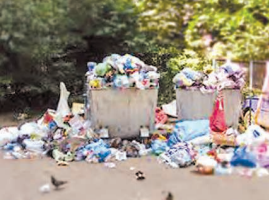
‘Disposal of waste’ means ‘to get rid of waste’. The disposal of waste should be done in a scientific way. There are different methods of waste disposal. The method to be used depends on the nature of the waste. Some of the important modes of waste disposal are.
- Recycling
- Preparation of compost
- Incineration
- Landfill
- Sewage treatment
We will now describe all these methods of waste disposal (or garbage disposal) briefly, one by one. Let us start with recycling.
“KSEEB SSLC Chapter 5 Our Environment important topics”
Recycling
The solid wastes like paper, plastics and metals, etc., are recycled. For example, waste paper is sent to paper mills where it is reprocessed to form new paper once again. The broken plastic articles like plastic bags, buckets, bowls, cups, plates, etc., are sent to plastic processing factories where they are melted and remoulded to make new articles. Similarly, waste metal articles are sent to metal industries where they are melted and recycled as solid metal for various purposes.
Preparation of Compost
Biodegradable domestic wastes such as left-over food, fruit and vegetable peels, and leaves of potted plants, etc., can be converted into compost by burying in a pit dug into ground, and used as manure.

Incineration
- ‘Incineration’ means ‘reducing to ashes’. The burning of a substance at high temperature (of more than 1000°C) to form ash is called incineration. Incineration is used to destroy household waste, chemical waste and biological waste (like that from hospitals).
- Incineration greatly reduces the volume of the waste. This is because when the large volume of waste material is burned, then only a small amount of ash is left behind which can be disposed of by landfill. Incineration is carried out in an incinerator (which is a kind of furnace).
- The waste disposal on large scale by using incinerators is done by the Municipality of a City. The solid waste is burned at a high temperature in the incinerator. All the organic matter present in waste is removed as carbon dioxide and water vapour. The ash left behind is removed from time to time.
Landfill
The disposal of wastes by putting it in low-lying areas of ground and covering it with earth is called landfill. Most of the solid waste in urban areas (which cannot be disposed of by other methods) is dumped in low-lying areas of ground and covered with earth to level the uneven ground. A big landfill site can be used to dispose of waste materials (or garbage) for a considerable time

Sewage Treatment
- The dirty drain water containing urine and faeces which is carried from our homes by the underground pipes (called sewers) is called sewage. If untreated sewage is dumped into a river, it can pollute the river water. Thus, sewage is disposed of by treating it at the sewage treatment plant (or sewage works).
- The treatment of sewage produces clean water which is discharged into the river. The organic matter present in sewage is ‘digested’ in the digesters of sewage treatment plant to produce ‘sewage gas’ (which is a kind of biogas), and ‘manure’.
- We will now give an example to illustrate how the use of biodegradable and non-biodegradable materials can make a difference to our environment. There was a time when tea in trains was served in plastic glasses which had to be returned to the vendor. This was, however, not a hygienic thing to do. Later on disposable plastic cups were introduced (which are used ‘once’ and then ‘thrown away’).
- Though it was hygienic to use a disposable plastic cup for drinking tea but the disposal of millions of plastic cups on daily basis posed a big problem. Sometime back ‘kulhads’ (disposable cups made of clay) were introduced for serving tea in trains.
- It was, however, soon realised that the use of a lot of clay for making millions of kulhads daily led to the loss of fertile top soil from fields (which was used for making kulhads). So, the practice of using ‘kulhads’ has also been discontinued. These days, disposable paper cups are being used.
- The use of disposable paper cups has the following advantages over the plastic cups :
- Paper cups are biodegradable. So, even if paper cups are thrown away after use, they will decompose (break down) automatically by the action of micro-organisms in due course of time. On the other hand, plastic cups are non-biodegradable. They will remain as such and pollute the environment.
- Paper cups can even be disposed of by burning without causing much air pollution. On the otherhand, burning of plastic cups produces toxic gases (poisonous gases) which cause too much airpollution.
KSEEB SSLC Class 10 Social Science Notes History
- Chapter 1 Advent of Europeans to India Notes
- Chapter 2 The Extension of the British Rule Notes
- Chapter 3 The Impact of British Rule in India Notes
- Chapter 4 Opposition to British Rule in Karnataka Notes
- Chapter 5 Social and Religious Reformation Movements Notes
- Chapter 6 The First War of Indian Independence (1857) Notes
- Chapter 7 Freedom Movement Notes
- Chapter 8 Era of Gandhi and National Movement Notes
- Chapter 9 Post Independent India Notes
- Chapter 10 The Political Developments of 20th Century Notes
KSEEB SSLC Class 10 Social Science Notes Political Science
- Chapter 1 The Problems of India and their Notes
- Chapter 2 Indian Foreign Policy Notes
- Chapter 3 India’s Relationship with Other Countries Notes
- Chapter 4 Global Problems and India’s Role Notes
- Chapter 5 International Institutions Notes
KSEEB SSLC Class 10 Social Science Notes Sociology
- Chapter 1 Social Stratification Notes
- Chapter 2 Labour Notes
- Chapter 3 Social Movements Notes
- Chapter 4 Social Problems Notes
KSEEB SSLC Class 10 Social Science Notes Geography
- Chapter 1 Indian Position and Extension Notes
- Chapter 2 Indian Physiography Notes
- Chapter 3 Indian Climate Notes
- Chapter 4 Indian Soils Notes
- Chapter 5 Indian Forest Resources Notes
- Chapter 6 Indian Water Resources Notes
- Chapter 7 Indian Land Resources Notes
- Chapter 8 Indian Mineral & Power Resources Notes
- Chapter 9 Indian Transport and Communication Notes
- Chapter 10 Indian Industries Notes
- Chapter 11 Indian Natural Disasters Notes
- Chapter 12 Indian Population Notes
KSEEB SSLC Class 10 Social Science Notes Economics
- Chapter 1 Development Notes
- Chapter 2 Rural Development Notes
- Chapter 3 Money and Credit Notes
- Chapter 4 Public Finance and Budget Notes
